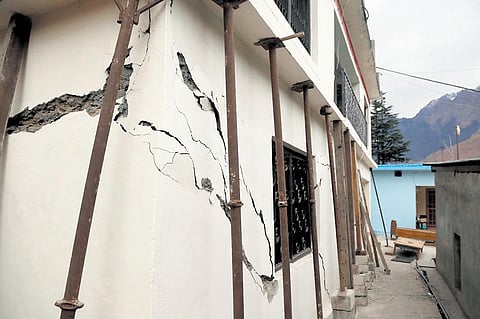

Cracks everywhere and no place to live, but Joshimath did not wake up to this scene one morning. The warnings about the dangers in Joshimath town have been repeatedly echoed for several years; the cracks started appearing long back, and with regards to the recent incident, residents began complaining of the cracks in November 2021, when they were found only in 14 houses. But with an escalated subsidence rate, massive cracks have appeared in around 678 identified houses, and others are to follow. While the lives and livelihoods of 25,000 people are in a precarious state and the whole world is watching the ancient holy town collapse bit by bit, how and why we reached this point of no return is an obvious question.
Joshimath is a town located on old glacial deposits, and it was known to be prone to land subsidence. It was advised in the 1970s that not even a tree should be cut in this area and no boulder should be excavated so that this town could stay somewhat stabilised and protected. However, this area has been systematically degraded, like many others in Garhwal – Himalayas.
Many factors contributed to the unfurling disaster in Joshimath, one of which is the construction of the Tapovan Vishnugad hydropower project coming up in the immediate vicinity—a project that should never have been sanctioned in the first place. Still, despite the warnings, it was permitted. After the 2013 disaster, the Supreme Court took suo moto cognisance of the “mushrooming of hydropower projects” (HEPs) in Uttarakhand.
Since then, the issue of HEP construction in Uttarakhand has been argued. Even though the government, in sworn affidavits, states that “it is pertinent to conclude that there has been a direct and indirect impact of the HEPs in the aggravation of the floods of 2013” (5/12/2014 affidavit by Environment ministry in SC) and that “in the larger public interest, the safety of the people living in these areas along with the interest of the pristine environment, biodiversity…and the commitment for the concept of sustainable development and precautionary principle…there is a need for a review of these projects” (31/05/2016 affidavit by Water ministry in SC), it allows for HEPs to continue functioning.
After the 2013 disaster, while the SC asked the governments to assess the effect of the existing wounds on the Himalayas, implying the under-construction and existing HEPs, the discussion was conveniently turned towards proposed HEPs. The government submitted in 2014 that there is a requirement for a “detailed study” with a set of specific experts like a climatologist, seismologist, social scientist, hydrogeologist, etc. The aim was to study micro-climatic changes and hydrogeological studies, the carrying capacity and the segregation of go/no-go areas for HEP constructions. However, contrarily in 2015, a committee was formed overriding all previous committees, chaired by a dam engineer who gave sanctions to all proposed projects and submitted that all is well for the construction of HEPs in the state. There arose an inter-ministerial conflict on the issue of HEPs versus Ganga rejuvenation—the other government mandate directly opposed its “developmental agenda”. Resolving the same in 2019, the minutes of a PMO meeting states, “No new hydro-electric project shall be taken up on River Ganga or its tributaries in the State of Uttarakhand. All projects in which the work has not started on the ground shall be dropped”. They also said that projects that are permitted to continue should be more than 50% completed on the ground. Despite this, projects with less than 50% completion (Vishnugad Pipalkoti) and even those completely destroyed in disasters (Phata Byung, Tapovan Vishnugad) were allowed.
As if massive deforestation, tunnelling, muck dumping, and heavy machinery-related impacts due to HEP construction were not enough, the government also introduced the Char Dham road widening project in the same region. It was contrary to its own notification of limiting the widening to 5.5 m to prevent slope destabilisation. The government arbitrarily decided to widen the road to 10 m instead. When challenged, it was approved under the pretext of “defence needs”, as if defence infrastructure doesn’t need a stable environment.
A report titled ‘Uttarakhand Action Plan for Climate Change 2020’ states that regulation of tourism is an essential next step. Still, contrary to its own submission, the state government boasts of a record number of tourists visiting the Char Dhams in the last yatra season and unabashedly advertises its massive tourism plans such as bugyals, heritage sites as wedding destinations, helicopter as taxis, tunnels as parking spaces, etc. Tunnelling for Char Dham railways is envisaged at a massive scale, and railways do not even need an environmental impact assessment, so there are no mandated steps for damage control. We shudder even to imagine the cumulative impact of these rapacious schemes, but for our governments, this is the only way towards “development”. More walk and less talk is needed in the face of no ecological carrying capacity study and several issues such as forest fires, increased soil erosion, black carbon deposition on glaciers, increased glacier melting, high sensitivity to land sinking, landslides and rising issues of climate change, and the preposterous and uncontrolled anthropogenic activities. The recent committee the government formed to assess the issues of Joshimath doesn’t have an independent expert, so holds no promise, as has been the case in the past.
What we see in Joshimath will soon happen in Bhatwari, where the Char Dham road widening is about to start and was only protected so far owing to the “Bhagirathi Eco-sensitive Zone” notification. Accelerated anthropogenic activities and climate change pose a grave danger to the Himalayan ecosystem. As a first step to mitigating future hazards, the upper catchment of the rivers from the glacier lines must be declared as Ecologically Sensitive Zones (ESZ) on the same lines as Bhagirathi ESZ and prohibit massive projects, regulate others and promote conservation projects.
C P Rajendran
Adjunct professor, National Institute of Advanced Studies, Bengaluru
Mallika Bhanot
Member of Ganga Ahvaan, a citizen forum
(Views are personal)